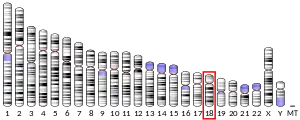| PIGN | |||||||||||||||||||||||||||||||||||||||||||||||||||
|---|---|---|---|---|---|---|---|---|---|---|---|---|---|---|---|---|---|---|---|---|---|---|---|---|---|---|---|---|---|---|---|---|---|---|---|---|---|---|---|---|---|---|---|---|---|---|---|---|---|---|---|
| Identifiers | |||||||||||||||||||||||||||||||||||||||||||||||||||
| Aliases | PIGN, MCAHS, MCAHS1, MCD4, MDC4, PIG-N, phosphatidylinositol glycan anchor biosynthesis class N | ||||||||||||||||||||||||||||||||||||||||||||||||||
| External IDs | OMIM: 606097 MGI: 1351629 HomoloGene: 6330 GeneCards: PIGN | ||||||||||||||||||||||||||||||||||||||||||||||||||
| |||||||||||||||||||||||||||||||||||||||||||||||||||
| |||||||||||||||||||||||||||||||||||||||||||||||||||
| |||||||||||||||||||||||||||||||||||||||||||||||||||
| |||||||||||||||||||||||||||||||||||||||||||||||||||
| |||||||||||||||||||||||||||||||||||||||||||||||||||
| Wikidata | |||||||||||||||||||||||||||||||||||||||||||||||||||
| |||||||||||||||||||||||||||||||||||||||||||||||||||
Phosphatidylinositol glycan anchor biosynthesis, class N is a protein that in humans is encoded by the PIGN gene.[5]
Function
This gene encodes a protein that is involved in glycosylphosphatidylinositol (GPI)-anchor biosynthesis. The GPI-anchor is a glycolipid found on many blood cells and serves to anchor proteins to the cell surface. This protein is expressed in the endoplasmic reticulum and transfers phosphoethanolamine (EtNP) to the first mannose of the GPI anchor.
Clinical aspect
Mutations in PIGN cause Congenital Diaphragmatic Hernia.[6]
References
- 1 2 3 GRCh38: Ensembl release 89: ENSG00000197563 - Ensembl, May 2017
- 1 2 3 GRCm38: Ensembl release 89: ENSMUSG00000056536 - Ensembl, May 2017
- ↑ "Human PubMed Reference:". National Center for Biotechnology Information, U.S. National Library of Medicine.
- ↑ "Mouse PubMed Reference:". National Center for Biotechnology Information, U.S. National Library of Medicine.
- ↑ "Entrez Gene: Phosphatidylinositol glycan anchor biosynthesis, class N".
- ↑ Brady PD, Moerman P, De Catte L, Deprest J, Devriendt K, Vermeesch JR (September 2014). "Exome sequencing identifies a recessive PIGN splice site mutation as a cause of syndromic congenital diaphragmatic hernia". European Journal of Medical Genetics. 57 (9): 487–93. doi:10.1016/j.ejmg.2014.05.001. PMID 24852103.
Further reading
- Chen CP, Lin HM, Leung C, Lin SP, Su YN, Su JW, Chen YT, Wang W (2012). "Partial monosomy 9p (9p22.2-->pter) and partial trisomy 18q (18q21.32-->qter) in a female infant with anorectal malformations". Genetic Counseling. 23 (2): 201–6. PMID 22876578.
- Kinoshita T, Inoue N (December 2000). "Dissecting and manipulating the pathway for glycosylphos-phatidylinositol-anchor biosynthesis". Current Opinion in Chemical Biology. 4 (6): 632–8. doi:10.1016/s1367-5931(00)00151-4. PMID 11102867.
- Gaynor EC, Mondésert G, Grimme SJ, Reed SI, Orlean P, Emr SD (March 1999). "MCD4 encodes a conserved endoplasmic reticulum membrane protein essential for glycosylphosphatidylinositol anchor synthesis in yeast". Molecular Biology of the Cell. 10 (3): 627–48. doi:10.1091/mbc.10.3.627. PMC 25192. PMID 10069808.
- Hong Y, Maeda Y, Watanabe R, Ohishi K, Mishkind M, Riezman H, Kinoshita T (December 1999). "Pig-n, a mammalian homologue of yeast Mcd4p, is involved in transferring phosphoethanolamine to the first mannose of the glycosylphosphatidylinositol". The Journal of Biological Chemistry. 274 (49): 35099–106. doi:10.1074/jbc.274.49.35099. PMID 10574991.
- McDonough CW, Bostrom MA, Lu L, Hicks PJ, Langefeld CD, Divers J, Mychaleckyj JC, Freedman BI, Bowden DW (December 2009). "Genetic analysis of diabetic nephropathy on chromosome 18 in African Americans: linkage analysis and dense SNP mapping". Human Genetics. 126 (6): 805–17. doi:10.1007/s00439-009-0732-8. PMC 2937163. PMID 19690890.
- Maydan G, Noyman I, Har-Zahav A, Neriah ZB, Pasmanik-Chor M, Yeheskel A, Albin-Kaplanski A, Maya I, Magal N, Birk E, Simon AJ, Halevy A, Rechavi G, Shohat M, Straussberg R, Basel-Vanagaite L (June 2011). "Multiple congenital anomalies-hypotonia-seizures syndrome is caused by a mutation in PIGN". Journal of Medical Genetics. 48 (6): 383–9. doi:10.1136/jmg.2010.087114. PMID 21493957. S2CID 39973123.
This article incorporates text from the United States National Library of Medicine, which is in the public domain.
This article is issued from Wikipedia. The text is licensed under Creative Commons - Attribution - Sharealike. Additional terms may apply for the media files.



